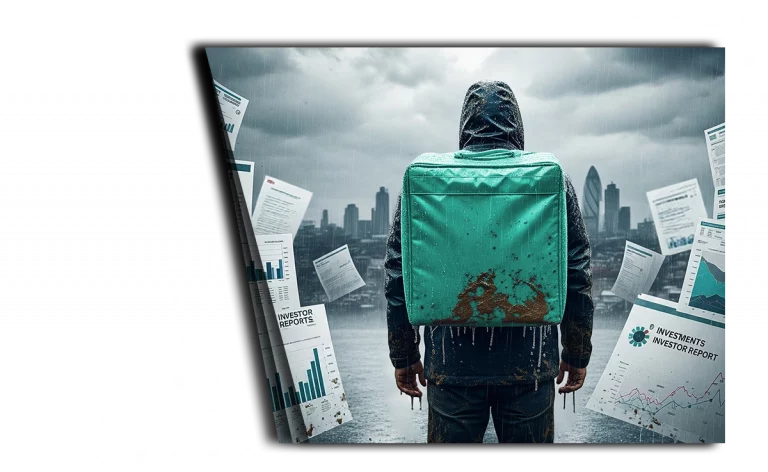
- Blog
Deliveroo and the Delivery Dream That Never Was: How M&A Hype Left Investors Hungry

SHARE:
The meal delivery sector promised the future. What investors got instead was a cold serving of disappointment.
Not long after Just Eat Takeaway agreed to sell itself to Prosus for £3.4 billion—down dramatically from its previous highs—another big name in food delivery, Deliveroo, is poised to follow a similar trajectory. The company has received a £2.7 billion acquisition offer from US-based DoorDash. Despite the offer carrying only a modest 20% premium over Deliveroo’s depressed share price, the board is recommending it.
For investors, it’s a bitter pill: the likely end of a public company that launched on the London Stock Exchange at a valuation of £7.6 billion in 2021. Deliveroo shareholders are staring down losses of nearly two-thirds of their original investment. And in many ways, they’re the last ones to be paid—if at all—after years of M&A activity that has served everyone except those who funded the delivery dream.
A Reality Check for the Delivery Sector
The deal may appear to be a vote of confidence from DoorDash, but in reality, it’s a strategic retreat dressed up as consolidation. Deliveroo’s leadership appears to have concluded—reluctantly—that there are no viable options left for standalone success.
That’s no small admission. Despite operations in 10 countries and partnerships with 180,000 restaurants, the platform has failed to achieve sustainable profitability. Nor is Deliveroo alone in this struggle. The entire sector has battled to convert pandemic-era demand into a durable business model.
Just Eat’s £7.3 billion acquisition of Grubhub in 2021—now widely viewed as a cautionary tale—serves as an example. Investors assumed Covid-19 had permanently changed consumer habits. That assumption proved costly.
Post-Pandemic Demand: A Misread of Market Signals
Many delivery businesses entered the public markets or undertook major acquisitions during the Covid boom, expecting home dining to remain a permanent fixture. Instead, as lockdowns lifted and dining out returned, delivery volumes stalled. Share prices fell in tandem.
While market conditions rebounded in other sectors, the delivery business stagnated. Why? Because the fundamentals of the industry—low margins, high operating costs, and fragile unit economics—never really improved. They were simply masked by a temporary surge in volume.
Compounding the issue, costs have risen across the board. Rider pay expectations have increased, minimum wages have risen, regulatory scrutiny has grown, and tax authorities are demanding better data and compliance. Even basic operating costs—insurance, platform development, customer support—continue to climb.
No Profits, No Growth, No Problem?
If demand is soft and costs are rising, then where’s the upside?
That’s the question prospective investors are now grappling with. And increasingly, the answer is: there isn’t one.
Unlike other sectors where consolidation can bring scale benefits, food delivery doesn’t respond well to M&A roll-ups. Bigger doesn’t mean better—it just means bigger losses. Even with fewer players, the business remains intensely competitive. The product (food) is commoditised, customer loyalty is minimal, and barriers to switching are virtually non-existent.
Rapid grocery delivery—a similar model with even slimmer margins—has already collapsed in many markets. The same fate may await standard takeaway delivery unless something fundamental changes.
Structural Limits of the Business Model
One of the core challenges is the simple truth that restaurants themselves operate on thin margins. Delivery platforms try to extract their share on top of this, but there’s only so much value to go around.
And customers, too, have limits. Delivery fees, surge pricing, service charges—these are tolerated up to a point. But when the cost of convenience outweighs the value of the meal itself, behaviour shifts. People revert to alternatives: cooking at home, picking up food directly, or dining out.
As Deliveroo and others have tried to drive volume through partnerships with fast-food giants like McDonald’s, their margins have only tightened. Big brands negotiate hard. They know their leverage and they’re not afraid to use it.
Workforce Realities: The Squeeze on Riders
The human element also plays a role in the sector’s struggles. Rider costs have increased, driven by regulation and a public push for better working conditions. Minimum wage requirements, holiday pay entitlements, and reclassification of gig workers are all eroding the thin layer of contribution margin many platforms relied on.
Some argue that these changes are long overdue—and they may be right. But the economic model that supported the delivery boom was, in large part, built on underpaid, highly flexible labour. That model is now being dismantled, with no clear replacement in sight.
The Hope of Niche Demand: Is There a Future?
Despite the bleak outlook, there may still be pockets of demand that could support a more modest, focused delivery model.
Affluent urban centres, where busy professionals are willing to pay a premium for convenience, might sustain profitable operations. Likewise, university towns and younger demographics—who tend to value time over money and have a higher digital affinity—remain a reliable customer base.
But these are niche markets. They do not justify the global scale and investment that platforms like Deliveroo, Just Eat, and DoorDash have pursued.
The M&A Playbook: When Consolidation is a Cover Story
Let’s be clear: the DoorDash-Deliveroo deal is not a celebration of sector strength. It’s a quiet admission of failure. The goal is not expansion, but survival—consolidating to remove redundancy, slash overheads, and perhaps claw back a path to profitability through scale-driven cost synergies.
This is the same rationale that underpinned Just Eat’s ill-fated purchase of Grubhub. And when that failed, Just Eat quietly sold itself.
We’ve seen this movie before.
A Familiar Endgame: When the Capital Dries Up
The trajectory is painfully familiar. It mirrors the demise of the rapid grocery delivery sector:
- Pandemic surge fuels massive fundraising and over-optimistic valuations.
- Investor FOMO leads to IPOs and mega-acquisitions at inflated prices.
- Reality bites as demand normalises and costs rise.
- Desperate M&A becomes the last strategy standing.
- Investors exit at a fraction of their entry price—if they exit at all.
Most of the original players in rapid grocery are gone. Bought for parts. Absorbed into larger platforms. Or vanished entirely after the capital tap ran dry.
Takeaway delivery appears to be following the same path, just more slowly.
Lessons for Dealmakers: When Growth Doesn’t Equal Value
This unfolding drama offers a cautionary tale for M&A professionals and corporate strategists:
- Valuation discipline matters. Market exuberance cannot substitute for fundamentals. Just because a sector is “hot” doesn’t mean every deal is good value.
- Synergies are not a cure-all. Combining two unprofitable businesses rarely creates one profitable one. The logic of consolidation only works when it addresses structural inefficiencies—which, in this case, it doesn’t.
- Exit strategy should be built-in. Deliveroo’s IPO was premised on scale and growth. When both evaporated, there was no fallback.
- Advisors always get paid. In boom or bust, M&A advisors, bankers, and consultants will find their fees. The real risk lies with equity investors—and they’ve taken the hit here.
Takeaway (no pun intended)
Deliveroo’s story is not unique. It reflects a broader overreach across the gig economy, where short-term demand was misread as a long-term trend, and the fundamentals never caught up to the hype.
The impending acquisition by DoorDash may offer a softer landing—but it will not reverse the destruction of shareholder value. Nor will it solve the business model’s structural flaws.
If anything, this deal marks the final act of a sector that promised transformation but delivered only temporary convenience—and long-term losses.
For investors, the lesson is clear: be wary of businesses that scale without profit, compete without differentiation, and rely on assumptions that convenience alone guarantees loyalty.
Because in the end, not all disruption is value creation—and not all growth deserves a premium.
TAGS:


Stay up to date with M&A news!
Subscribe to our newsletter


